Tōkyō Subway Lines and Trains
In addition to commuter and high-speed lines, Tōkyō has a number of heavy-rail subway lines operated by two companies: Tōkyō Metro and Toei (short for the Tōkyō Metropolitan Bureau of Transportation). Tōkyō Metro is a private company jointly owned by the national and metropolitan government, while Toei is now a metropolitan government agency formed to operate lines originally nationalized by the government in the second world war (and some lines owned by the Tōkyō city government prior to that). Prior to 2004 the Tōkyō Metro was the Teito Rapid Transit Authority (or Corporation), TRTA, also known as Eidan (which means “corporation”) and the old nickname is still sometimes used informally.
Tōkyō Metro operates nine lines (one of which has a branch line). Seven of these use the same narrow-gauge track (1067 mm) and overhead 1,500 VDC power as the commuter railways, and operate run through service with JR or other commuter railways. The other two lines (the oldest) use standard gauge track (1435 mm) and third-rail 600 VDC power, and do not operate run-through service.
The Toei lines are a bit odd by Tōkyō standards: all four lines use 1500 VDC overhead power, but only one is narrow gauge with run-through service. Two others are standard gauge (one has run-through service with the Keikyū and Keisei railway’s lines), and the last is 1372mm gauge and operates run-through service with the Keio Corporation’s lines.
Trains used in run-through service need to be designed to the needs of the subway, with narrower (typically 2.8m vs 2.95m) cars than above-ground commuter lines, and end-door emergency exits. While some lines also use shorter cars, most have the same 20m length as typical commuter cars.
Despite all these run-through services, the subway networks of the two companies are independent, and separate tickets are needed for each (although pre-paid passes and transfer tickets are available).
Note: the information here has largely been gathered from English and Japanese Wikipedia pages, and is thus subject to inaccuracies (usually the English pages are a subset of the Japanese information, but sometimes the two contradict one another).
Tōkyō Metro 01 Series
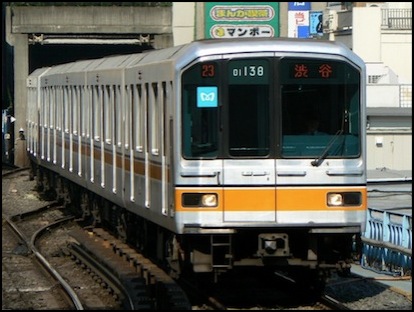
Photographer: The RW Place
The 01 Series (introduced 1984) is used on the 1435mm Ginza line (in 6-car trainsets). These cars do not run through to other lines and use third-rail 600 VDC instead of overhead power. The 01 series design won the 1985 Laurel prize. There are three motor cars per six-car set. See also Japanese Wikipedia.
Width: 2.55m
Length: 16.0m
Top Speed: 75 or 80 kph max (depending on electronic systems)
Operating Speed: 65 kph
Power: 1440 kW (1,931 hp)
Gauge: 1435mm (Standard gauge)
Tōkyō Metro 02 Series
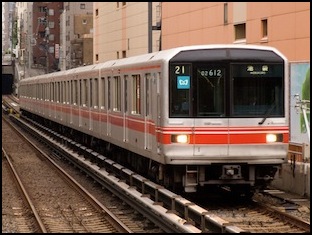
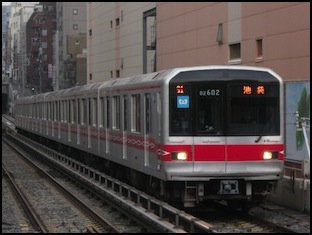
Photographers: LERK, and Resident of Higashi-fuchu
The 02 Series (introduced 1988) is used on the 1435mm Marunouchi line (in both 3- and 6-car trainsets). These cars do not run through to other lines and use third-rail 600 VDC instead of overhead power. There are three motor cars per six-car set, and two per three-car set. See also Japanese Wikipedia.
Width: 2.78m
Length: 18.0m
Top Speed: 75 or 80 kph max (depending on electronic systems)
Operating Speed: 65 kph on Marunouchi branch, 75 kph on Marunouchi main
Power: 1440 kW (1,931 hp) per 6-car set, 960 kW (1,287 hp) per 3-car set
Gauge: 1435mm (Standard gauge)
Tōkyō Metro 03 Series
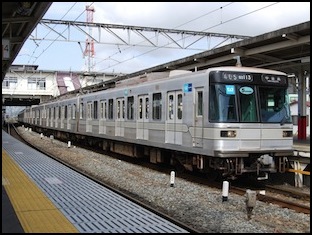
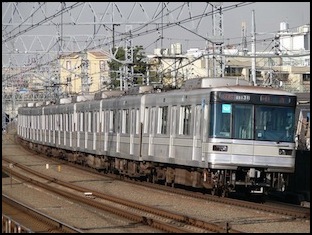
Photographers: M Ohtsuka and Chabata_k
The 03 Series (introduced 1988) is used on the Hibiya line in 8-car trainsets. These cars are equipped for run through service on the Tōkyū Tōyoko and Tōbu Isesaki lines. Some cars were built with 5 doors instead of 3. There are four motor cars per 8-car train. See also Japanese wikipedia.
Width: 2.78m
Length: 18.0m, 18.1m (cab)
Top Speed: 110 kph
Operating Speed: 80 kph on Hibiya, 100 kph on Tōbu Isesaki, 110 kph on Tōkyū Tōyoko
Power: early cars: 2560 kW (3,433 hp) per 8-car set, VVVF cars: 3040 kW (4,077 hp) per set
Gauge: 1067mm (Cape gauge)
Tōkyō Metro 05, 05N Series
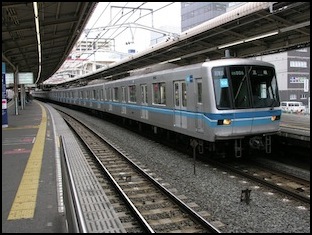
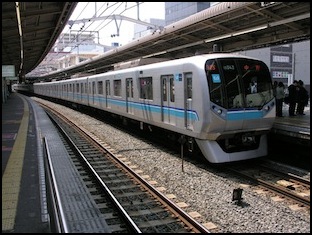
Photographer: Shadow Fox (both)
The 05 Series (introduced 1988) is used on the Tozai line in 10-car trainsets. There are several detail variants of this train type, see the wikipedia page for details. The most significant is the 05N (right photo above). These cars run through on the Tōyō Rapid Railway Line and outer sections of JR’s Chūō-Sōbu line. Early trainsets have had five motor cars per ten-car train, those built with VVVF electronics have four motor cars. The most recent trainset, built in 2004, used Hitachi’s modular A-train body construction. The Tōyō Rapid Railway 2000 Series was based on the 05, but has a slightly different design and lacks the systems required for operation on JR lines. See also Japanese Wikipedia.
Width: 2.8m
Length: 20m, 20.27 (cab)
Top Speed: 110 kph
Operating Speed: 100 kph on Tōzai line
Power: 3200 kW (4,291 hp)
Gauge: 1067mm (Cape gauge)
Tōkyō Metro 06 Series
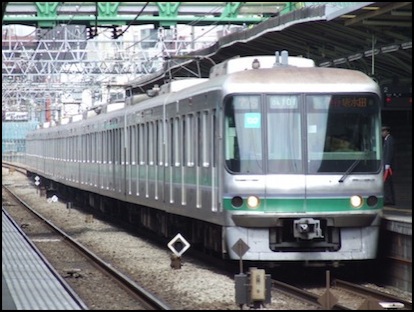
Photographer: Lover of Romance
The 06 Series (introduced 1993) is used on the Chiyoda line in a single 10-car trainset. This is also used in run through service on the Odakyū Odawara Line and JR’s Jōban line. See also Japanese Wikipedia.
Width: 2.8m
Length: 20m, 20.07m (cab)
Top Speed: 110 kph
Operating Speed: 80 kph on Chiyoda, 90 kph on Jōban, 100 kph on Odakyū
Power: 3280 kW (4,399 hp)
Gauge: 1067mm (Cape gauge)
Tōkyō Metro 07 Series
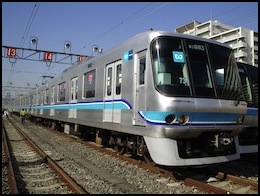
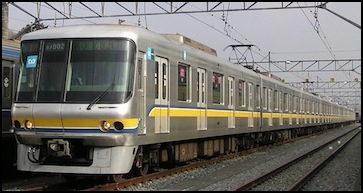
Photographers: Rsa and Ichikawa Taichi (市川太一)
The 07 Series (introduced 1992) is used on the Tōzai line in 10-car trainsets. One set has been used on the Chiyoda line since 2008. From the Tōzai line these cars run through on the Tōyō Rapid Railway Line and JR’s Chūō-Sōbu line. Previously (prior to 2008) these were also used on the Yūrakuchō line (right photo above). There are four motor cars per 10-car trainset. See also Japanese Wikipedia.
Width: 2.8m
Length: 20m (20.07m for Cab cars)
Top Speed: 110 kph
Operating Speed: 100 kph
Power: 3280 kw
Gauge: 1067mm (Cape gauge)
Tōkyō Metro 08 Series
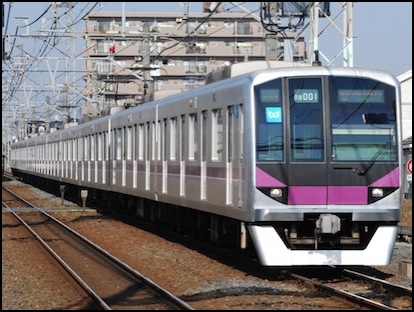
Photographer: M Ohtsuka
The 08 Series (introduced 2003) is used on the Hanzōmon line in 10-car trainsets. The design was based on the 05N, although there are detail differences. These trains run through on the Tōkyū Den-en-toshi and Tōbu Isesaki Lines. There are five motor cars per ten-car set. See also Japanese Wikipedia.
Width: 2.78m
Length: 20m, 20.24m (cab)
Top Speed: 120 kph
Operating Speed: 80 kph on Hanzōmon, 100 kph on Tōbu Isesaki, 110 kph on Tōkyū Den-en-toshi
Power: 3300 kw (4,425 hp)
Gauge: 1067mm (Cape gauge)
Tōkyō Metro 5000 Series
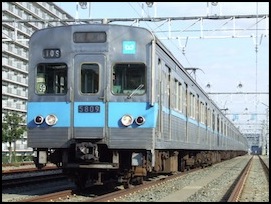
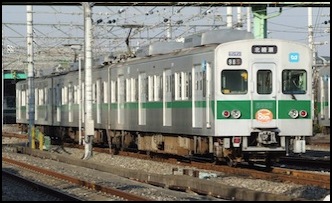
Photographer: Lover of Romance (both)
The 5000 Series (introduced 1964) is used on the Chiyoda line (branch line) in 3-car trainsets and until 2007 on the Tōzai line in 10-car trainsets. These cars do not presently run through on another line, but when on Tōzai service they were also used on run through service to JR’s Chūō-Sōbu line and the Tōyō Rapid Railway Line. Additionally, a dozen sets were converted to make the Tōyō Rapid 1000 series, used on that line until 2008. These are an old design, and the earliest versions were built in stainless steel (left photo above), although newer ones use aluminum (right photo above). Only two 3-car sets remain in service. Three car sets have two motor cars, ten car sets had eight motor cars, they were also operated in seven and eight car sets with six motor cars. See also Japanese Wikipedia.
Width: 2.87m (cab), 2.856m stainless steel intermediate, 2.852m aluminum intermediate
Length: 20.0m
Top Speed: 100 kph
Operating Speed: 100 kph (Tōzai line), 75 kph (original Chiyoda line)
Power: 3200 kW (4,291 hp; ten-cars), 2400 kW (3,218 hp; six or seven cars), 800 kW (1,073 hp; three cars)
Gauge: 1067mm (Cape gauge)
Tōkyō Metro 6000 Series
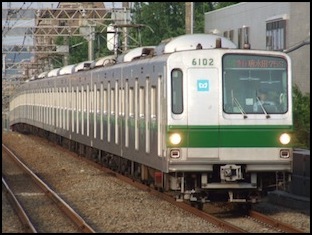
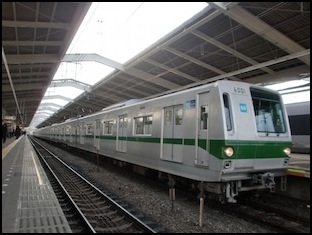
Photographers: Lover of Romance, and STTrain
The 6000 Series (introduced 1971) is used on the Chiyoda line (main and branch line) in 3- and 10-car trainsets. These cars run through on the Odakyū Odawara Line and JR’s Jōban line. The ten-car sets have six motor cars. The design won the 1972 Laurel prize. See also Japanese Wikipedia.
Width: 2.87m (Japanese wikipedia says 2.80m)
Length: 20.0m
Top Speed: 100 kph
Operating Speed: 100 kph (80 kph on Chiyoda line)
Power: 3480 kW (4,667 hp; ten-car sets)
Gauge: 1067mm (Cape gauge)
Tōkyō Metro 7000 Series
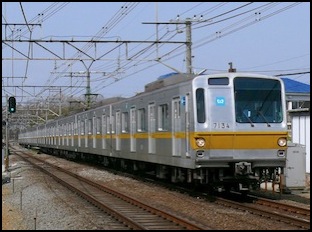
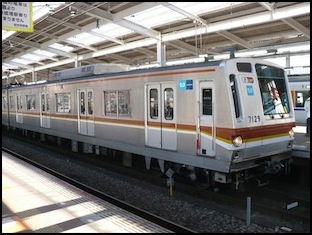
Photographers: まも (Mamo), and The RW Place
The 7000 Series (introduced 1974) is used on the Yūrakuchō line in 10-car trainsets and from about 2007 the Fukutoshin line in 8-car trainsets (right photo above; previously all trains were 10-car sets, see left photo above). These cars run through on the Tōbu Tōjō Line, and the Seibu Yūrakuchō and Ikebukuro Lines. There were originally six motor cars per trainset, but this has been reduced to five for some sets and motors have been upgraded to have more power (according to Japanese wikipedia, most ten-car sets have five motor cars although some have six, and all eight-car sets have four motor cars; but this may reflect current usage, not original).
Width: 2.8m
Length: 20.0m
Top Speed: 100 kph
Operating Speed: 80 kph on Yūrakuchō line, 100 kph on Tōbu line
Power: 3960 kW (5,310 hp; updated motors, six motor cars), 2640 kW (3,540 hp; updated, four motor cars)
Gauge: 1067mm (Cape gauge)
Tōkyō Metro 8000 Series
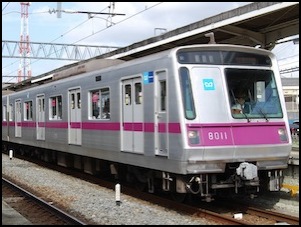
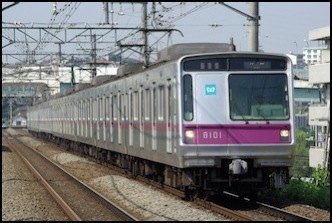
Photographers: M Ohtsuka, and Yaguchi
The 8000 Series (introduced 1980) is used on the Hanzōmon line in 10-car trainsets. Trains on this line run through on the Tōkyū Den-en-toshi and Tōbu Isesaki Lines, although these trains may only run through on the Tōkyū line. Originally with six motor cars per trainset, this was reduced to five with VVVF controls and upgraded motors. See also Japanese Wikipedia.
Width: 2.78m
Length: 20.0m
Top Speed: 100 kph
Operating Speed: 80 kph (Hanzōmon line), 100 kph (Tōkyū line)
Power: 3840 kW (5,150 hp; original 6M4T sets), 3300 kW (4,425; upgraded 5M5T sets)
Gauge: 1067mm (Cape gauge)
Tōkyō Metro 9000 Series
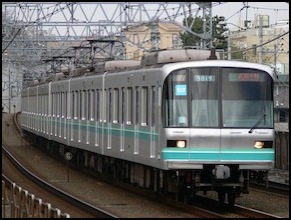
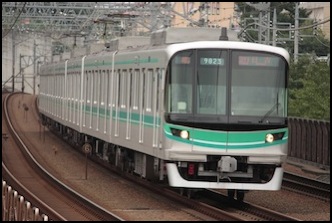
Photographers: Chabata k, and Jet-0
The 9000 Series (introduced 1991) is used on the Namboku line in 6-car trainsets, with new sets added as late as 2009. These cars run through on the Tōkyū Meguro Line, and the Saitama Rapid Railway Line (a portion of which is shared with the Toei Mita line). With the fifth batch of cars, produced in 2009, the number of motor cars was reduced from six per train to four and other substantial changes were made (right photo above). See also Japanese Wikipedia.
Width: 2.78m
Length: 20.0m, 20.66 (cab car)
Top Speed: 110 kph
Operating Speed: 80 kph (Namboku line), 110 kph (Tōkyū line)
Power: 3040 kW (4,077 hp; new 4M6T sets)
Gauge: 1067mm (Cape gauge)
Tōkyō Metro 10000 Series
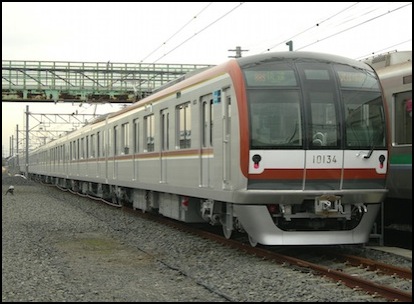
Photographer: Rsa
The 10000 Series (introduced 2006) is used on the Yūrakuchō and Fukutoshin lines in 10-car sets (see below). These trains were build using Hitachi’s modular A-train body construction. These cars run through on the Tōbu Tōjō and Seibu Yūrakuchō and Seibu Ikebukuro Lines today, and some sets were reduced to 8-car sets for use on the Fukutoshin line; in 2012 these will also be used for run-through service to the Tōkyū Tōyoko line. The ten car sets have five motor cars. See also Japanese Wikipedia.
Width: 2.8m (2.85m “maximum”)
Length: 20m (20.47m car cars)
Top Speed: 120 kph
Operating Speed: 80 kph on Tōkyō Metro lines, 100 kph on Tōbu lines and 105 kph on Seibu lines.
Power: 3300 kW (4,425 hp; ten-car set)
Gauge: 1067mm (Cape gauge)
Tōkyō Metro 15000 Series
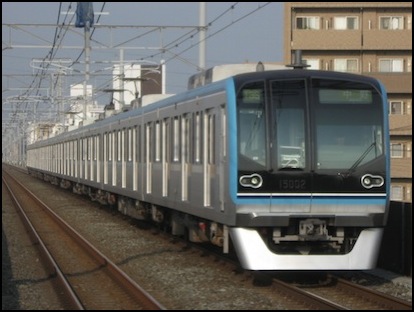
Photographer: Resident of higashi-fuchu
The 15000 Series (introduced 2010) is used on the Tōzai line in 10-car trainsets. These cars run through on JR’s Chūō-Sōbu line. The design is based on the 10000 Series, but has wider doors. There are five motor cars per 10-car train. See also Japanese Wikipedia.
Width: 2.85m
Length: 20m (2.47m cab cars)
Top Speed: 110 kph
Operating Speed: 100 kph on the Tōzai line, 95 kph on the Chūō-Sōbu line
Power: 4500 kW (6,035 hp)
Gauge: 1067mm (Cape gauge)
Tōkyō Metro 16000 Series
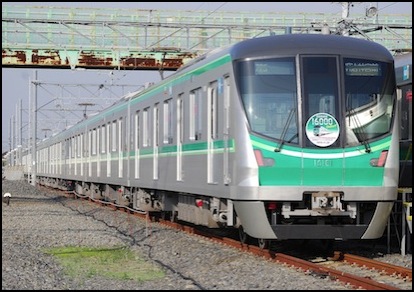
Photographer: toshinori baba
The 16000 Series (introduced 2010) is used on the Chiyoda line in 10-car trainsets. These cars run through on the JR’s Jōban line and the Odakyū line. There are four motor cars per 10-car train. The design won the 2011 Laurel prize. See also Japanese Wikipedia.
Width: 2.8m
Length: 20.0m (20.47m cab)
Top Speed: 110 kph
Operating Speed: 80 kph (Chiyoda line), 90 kph (Jōban), 100 kph (Odakyū line)
Power: 3280 kW (4,399 hp)
Gauge: 1067mm (Cape gauge)
Toei 5300 Series
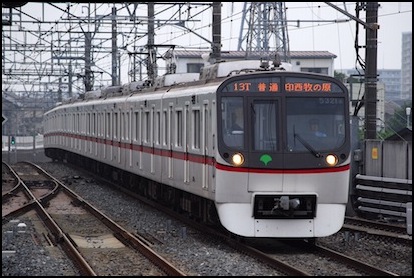
Photographer: toshinori baba
The 5300 Series (introduced 1991) is used on the 1435mm Asakusa line in 8-car trainsets. The seventh trainset (number 5327) was built for run-through 120 kph operation on the Keikyū Airport (Keikyū Kūkō) line to Haneda Airport and has a slightly different design. There are four motor cars per train. See also Japanese Wikipedia.
Width: 2.8m
Length: 18.0m
Top Speed: 110 kph (120 kph for 5327)
Operating Speed: 110 kph
Power: 2640 kW (3,540 hp), 2880 kW (3,862 hp; set 5327)
Gauge: 1435mm (Standard gauge)
Toei 6300 Series
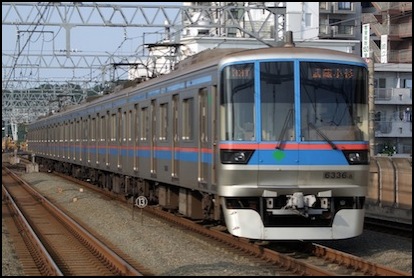
Photographer: yaguchi (矢口)
The 6300 Series (introduced 1993) is used on the 1067mm Mita line in 6-car trainsets. These are also used on run through service to the the Tōkyū Tōyoko line. There are three motor cars per six-car set. See also Japanese Wikipedia.
Width: 2.783m
Length: 20.0m, 20.25m (cab)
Top Speed: 120 kph
Operating Speed: 75 kph on the Mita line, 110 kph on the Tōkyū Tōyoko line
Power: 2160 kw (2,897 hp)
Gauge: 1067mm (Cape gauge)
Toei 10-000 Series
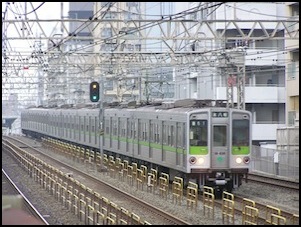
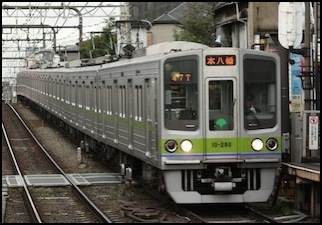
Photographers: Ichikawa Taichi (市川太一), and ナポ@
The 10-000 Series (introduced 1978, although a prototype was tested on the Mita line from 1971) is used on the 1372mm Shinjuku line in 8-car trainsets. These sets had six motor cars. The design underwent a number of minor changes over the years (compare the two photos above). It would appear that prior to 2006 some ten-car sets were used with the Keiō Sagamihara line. The cars are being recycled into the new 10-300R sets. See also Japanese Wikipedia.
Width: Unknown, but likely 2.77m
Length: 20.0m
Top Speed: 120 kph
Operating Speed: 110 kph (likely a reference to the Keiō line; the Shinjuku line is restricted to 75 kph)
Power: 3960 kW (5,310 hp) - This number seems too high to be correct
Gauge: 1372mm
Toei 10-300/10-300R Series
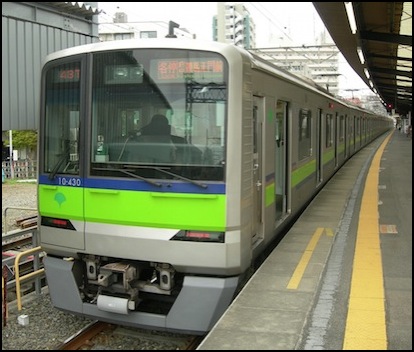
Photographer: Rsa
The 10-300 Series (introduced 2004 as a replacement for the 10-000) is used on 1372mm Shinjuku line in 8-car trainsets. It would appear that there are also some 10-car sets (likely used on the Keiō Sagamihara line, although that isn’t clear). The control systems are derived from those used on JR’s E231, and the 10-300R uses 10-300 head cars with 10-000 intermediate cars. The 10-300 8-car sets have five motor cars, while ten-car sets have six, however the 10-300R is only used in 8-car sets with six motor cars. See also Japanese Wikipedia.
Width: 2.77m
Length: 20.0m, 20.15m (cab)
Top Speed: 120 kph
Operating Speed: 75 kph on the Shinjuku line, 110 kph on the Keiō line
Power: unclear; two different motor sizes are used 95 kW (380 kW/car) and 165 kW (660 kW/car)
Gauge: 1372mm
Toei 10-490F Series
(no photo yet)
The 10-490F series was introduced in 2013 as a replacement for the 10-300 trains on the Shinjuku line. Information is scarce, but these appear to be based on the E233-2000 design used on the JR East Jōban line and the Tōkyō Metro Chiyoda line. These appear to also be ten-car sets based on the prototype, but the information may be incorrect. The E233-2000 uses ten-car sets with a 6M4T design having 3.36 kW total power and a top speed of 90 kph.
What little info I have on this comes from the Japanese Wikipedia 10-300 page, and a railf.jp post about the prototype, pointed out by JR Forum reader Miyakoji. The latter has a photo, which is similar but not identical to the JRE Jōban line E233-2000 pictured further down this page.
Width: 2.80m (to be verified)
Length:
Top Speed: 90 kph (to be verified)
Operating Speed: unknown
Power: unknown, but likely 560 kw per powered car
Gauge: 1372 mm
Toei 12-000 Series
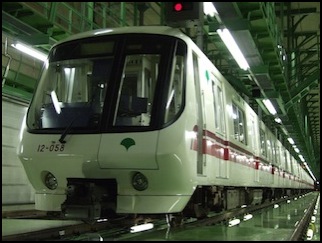
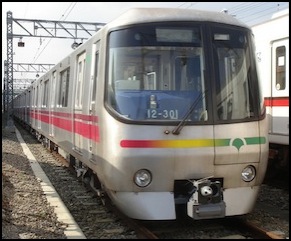
Photographers: Lover of Romance, and UEPON-2600
The 12-000 Series (introduced 1990) is used on the 1435mm Ōedo line in 8-car trainsets. This design appears to use a single 120 kW motor per truck with all trucks powered. This is different from the usual approach of putting one motor per axel (two per truck) and only powering some cars. It appears that cars produced after 1997 used an unpainted brushed-steel finish. while earlier ones were painted.
Width: 2.498m
Length: 16.5m intermediate, 16.75m cab cars
Top Speed: 70 kph
Operating Speed:
Power: 1920 kW (2,575 kw)
Gauge: 1435mm (Standard gauge)
Note: Toei also operates a light-rail line and a monorail line, not included here.
JR E231-800 Series
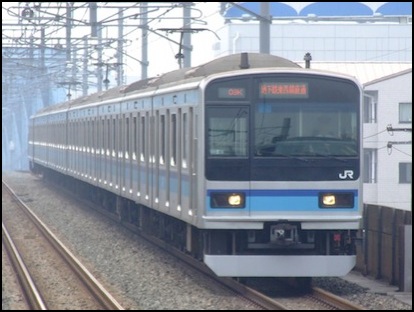
Photographer: LERK
The E231-800 is a variant of the E231 commuter train with a narrower body (2.8m vs 2.95m) and an end-door emergency exit, for run-through operation between the Tōkyō Metro Tōzai line and JR’s Chūō-Sōbu line.
JR E233-2000 Series
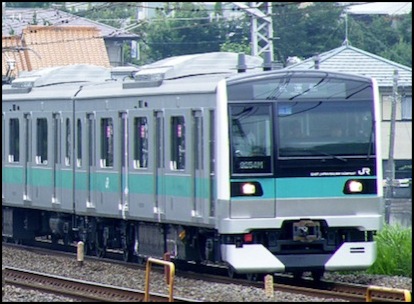
Photographer: Alt_winmaerik
The E233-2000 is a variant of the E233 commuter train with a narrower body (2.8m? vs 2.95m) and an end-door emergency exit, for run-through operation between the Tōkyō Metro Chiyoda line and JR’s Jōban line.




